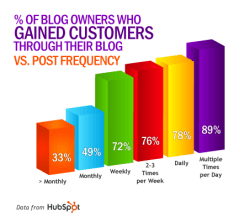
The impact of social media on sales and revenue is still something that businesses struggle to measure, even with its wide use in marketing. And without knowing the hard numbers, it can be difficult to improve your current strategy.
However, by using certain methods and tools, you can begin putting a dollar value on the return of your social media investment. From there, you can begin to apply what you’ve learned to increase your overall ROI from social media.
In this article, we will firstly look at the primary ways to use social media from a commercial perspective, then walk you through the process of turning your social media goals into hard numbers you can optimize over time.
The Multiple Functions Of Social Media
To establish effective social media goals, you need a clear understanding of how social media can play an effective role in your business.
To do so, consider the perspective of the customer. According to MarketingSherpa, the top three reasons people follow social media accounts are:
- For coupons and promotions.
- Existing interest in buying products.
- For an incentive, such as a discount or a gift card.
And yet, social media doesn’t begin and end with the marketing team. For example:
- Design and development can give your audience a peek behind the curtain by showing what it looks like to spend a day in the office. This creates transparency and greater ‘intimacy’ for customers, while potentially also attracting new talent.
- PR can execute proactive outreach without being intrusive in your customers’ daily lives. This ranges from recommendations to a simple thank you when someone mentions your brand.
- Sales can establish one-to-one relationships before reaching out over the phone.
- Customer support can offer immediate replies to time-sensitive messages that would otherwise get lost in a sea of support tickets.
How you decide to leverage social media ultimately depends on your business’ goals, but one thing is for sure: social media as a marketing medium can be highly effective – if you can measure, analyze, and iterate on your successes.
Tracking And Assigning Fiscal Values To Results
Unfortunately, the fiscal value of social influence can seem abstract, but there are ways in which you can objectify your investment in social media. In simple terms, you simply account for what you can to learn how to better direct your investments in a positive direction. After all, measuring something – even if the means of measurement is imperfect – is better than measuring nothing.
With that in mind, we’ve broken down the process of measuring social ROI into four steps below. By the time we’re done, you’ll have a solid framework in place for both observing the efficacy of social media marketing, and improving your efforts to encourage a greater return on investment.
Step 1: Know Which Metrics To Track
While you can follow a myriad of metrics when it comes to social media, you will be best served limiting yourself to a handful.
There is no definitive list of the ‘right’ and ‘wrong’ metrics; in fact, the metrics you choose to measure will depend largely on your business’ goals, and are likely to change over time.
That said, we can certainly give you some suggestions:
- Reach: The number of users who see a particular update divided by the number of followers online at the time.
- Engagement: The sum of interactions across any given social media platform divided by the total number of followers. We’re talking likes, shares, comments, retweets, repins, bookmarks, favorites, etc.
- Traffic: The number of users who are directed to your physical store or website from links within your social media accounts.
- Conversions: The number of conversions made on your site (sales, signups, etc.) divided by the amount of traffic you receive from social media.
In reality, you’re likely to find yourself drawn to those metrics that offer the closest possible relation to tangible results (e.g. conversions). That said, you should also bear in mind the less tangible ways in which social media can contribute to your business’ bottom line.
Step 2: Measure Your Metrics Over Time
There are a lot of ways to measure your chosen metrics over time.
To get started, check out the native insights offered by each platform. Get familiar with tools such as Facebook Insights and Twitter Analytics to get to grips with the data available from these services. That said, while these tools are insightful, they can become cumbersome to handle separately.
That’s where additional reporting tools come in. There are several well-known dashboard tools that act as swiss army knives for social media tracking. You’ve probably heard of Hootsuite, Buffer, Moz, and Kissmetrics; any of these will help track your interactions and manage your ongoing campaigns.
Taking things even further, you can find specialized tools that track more nuanced social media engagement. Awario and BuzzBundle both take conversation tracking and its associated analytics to the next level, and tools such as SEO SpyGlass track where your site is being linked to all around the web.
By tying your pick of the above to an analytics tool such as Google Analytics, you can begin to answer questions such as how much of your traffic comes from social media platforms, and how much of that traffic converts into sales.
Here’s how to make it happen:
- Choose your tracking tools.
- Decide which metrics to track in a regular report.
- Pick a regular reporting schedule.
- Follow that schedule!
Your reports can be weekly, monthly, or quarterly depending on your business goals. However, it’s important to find the right balance – too often means you may miss the woods for the trees, but not often enough means you won’t find critical data points that could completely change how you interpret the results.
Step 3: Compare Metrics To Your Goals
Your social media marketing team should be setting specific goals to line up with the metrics tracked in these reports.
Here are a few examples of goals they could be trying to reach:
- New followers
- Online purchases
- Contact form submissions
- Newsletter signups
- File downloads
- Clicks on a specific link
Every time a report comes in, compare it to your original goals. Consider which goals were reached and which were missed, and which strategies were used or changed. Finally (and most importantly!), given these answers, consider how your strategies can be improved in the future.
Step 4: Calculate Social ROI
Social ROI is calculated like the ROI of anything else in business (with the sum expressed as a percentage):
( ( return – cost ) / cost ) x 100
For example, if you calculated your investment in social media for a given period at $1,000, and you calculated a return of $1,200, the above formula would boil down to the following:
( ( 1200 – 1000 ) / 1000 ) x 100
However, how do you calculate the true revenue earned from the efforts of social media marketing? This involves a little bit of extrapolation, but ultimately it comes down to applying dollar values to the goals you track. For example:
- A purchase can be assigned an average dollar value.
- A newsletter signup can be assigned a value based on the average conversion rate of email subscribers to customers multiplied by your Customer Lifetime Value (CLV).
- A clickthrough can be assigned a value based on the conversion rate of website visits to customers (again, multiplied by your CLV).
What you end up with is hard numbers based on statistical analysis of sales and conversions. The outcome may not represent to a precise degree what is actually going on in your business, but it will provide you with a useful approximation, and most importantly, will serve as a milestone by which you can compare performance over time.
Conclusion
Even though there’s no strict way to measure the ROI of social media, you can establish a baseline of valuable data to help you make informed decisions about your strategy. Understanding the limitations and conditions when tracking social ROI is critical for framing your findings in the right light.
To get the hard numbers you need, follow these steps:
- Track the relevant metrics for your business.
- Measure these metrics over time.
- Compare the results to your goals, and use the outcome to improve your marketing.
- Calculate your ROI and compare it over time.
What parts of social media ROI do you struggle with the most? Let us know in the comments section below!
Hand-Picked Related Articles:
- A Framework For Assessing The Impact Of Your Blog On Company Sales
- Multi Armed Bandits & A/B Testing: Which Makes You More Money
- Dimensions & Metrics: Which Is What In Analytics
* Adapted lead image: Public Domain, pixabay.com via getstencil.com
How Do You Measure Social ROI?
The post How Do You Measure Social ROI? appeared first on Search Engine People Blog.
Search Engine People Blog(82)






